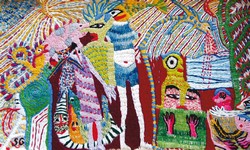Katarína Čierna
The Slovak National Gallery organised the 9th annual of the international art exhibition – The Triennial of Naïve Art Insita 2010 (03 July – 26 September 2010), the purpose of which was to present the specific values of untrained artistic expression. The special exhibition of textile art An Inspired Needle or Painted with a Needle organised under the curatorial guidance of French art theoretician Laurent Danchin was the highlight of this year. The exhibition displays various aspects of the art – from naïve art of the early 19th century to the examples of „brutal“ or visionary art of today, from the classical paintings to objects, from traditional embroidery, tapestries, applications, bobbin lace to patchwork.
Authors are of various ages, education, occupation and gender (26 participants of whom 7 were males). The delicate bead embroidery by French artist Sophie Berger from 1828 was presented. Hundred years later, Swiss woman Rosina Baumgartner-Bäbler (1900 – 1979) started to make embroideries decorated with flowers, animals and the Alps. Masterpiece made by Emma Widmer-Gass (1914 – 2007) named Where I stayed and lived comprises of 31 pictures at one place of 170 x 240 cm which display events from her life in Switzerland. Helga Sophia Goetze (1922 – 2008) was discovered lately when six of her provocative wall carpets were dedicated to Collection de l´ art brut in Lausanne. She used poetry and pictures to criticize society and promote sexual freedom. Adam Nidzgorski (1941) lived in Poland, Tunisia and France and, apart from his drawings of terrified children with large yeas that made him famous, he made ten large naïve textile tapestries of similar topics. Small embroideries Ray Materson (1954) from the U.S.A. are inspired by the European paintings, old photographs and the life in prison. In addition to her drawings and pastel pictures of unknown flowers and plants, Czech author Anna Zemánková (1908 – 1986) made the combinations of embroidery and pastel drawings and textile applications. The work of Russian artist Rosa Žarkich (1930) is also a combination f drawings and embroidery.
